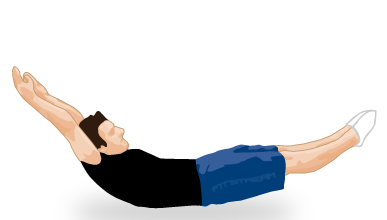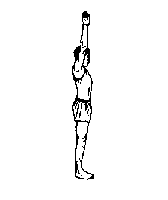There are 7 body shapes you'll need to know and how they are implied with the skills you are learning.
1. Straight- In the straight body position every joint is straight and showing no flexion, arching, or hollow. The straight body is commonly used when we do straight jumps, jump 1/2 turn, jump 1/1 turn, handstands, setting for a skill, front drop, back drop, front layout, and back layout, etc....
2. Tuck/ Puck- In the tuck position, both hips and knees are flexed and the body resembles a ball. I put puck in because its relevantly the same shape except the hips are less flexed than the tuck as if you would say a tuck candle stick or a hollowed tuck. The Puck is commonly used when an athlete is attempting a multiple flip with a twist. Tuck is more closed in at the hips. Tuck is can be used during a tuck jump, forward roll, backward roll, handstand, tuck support, tuck to seat drop on trampoline, front tuck, back tuck, etc...
3. Pike- In the pike position only the hips are flexed and the knees are straight. Pike can be used during a forward roll, backward rolls, handstand, pike, jump, seat drop, L-seat hold, front pike, back pike, pullover pike (trampoline), etc....

5. Hollow- In the hollow shape many coaches see the hollow as straight body. The hollow body is where the athlete lays down on their back while their shoulders are off the ground and feet off the ground where they show very little hip flexion but not piked or their back arched. In the hollow position, the body is in a crescent position where the stomach area seemed empty as nothing is there being hollow. The hollow body hold allows you to properly transfer force from upper body to your lower body without any energy leaks. This is an example of doing multiple BHS and Whips. Hollow body position can be applied to handstands, strength elements such as front levers, double layout, back layout, and front layout, etc.

6. Bow- The bow shape is a tight arch as if you are doing a superman hold. The bow shape is applied to back handspring, front handspring, whips, front layout, double layout, etc...
7. Arch- The arch shape is more extreme arch than the bow. The arch shape is applied to handstands (acrobatics), limbers and walkovers.
These are the seven body shapes and many of them can be combined and work together to make the tumbling skill more complete and mastered. Teaching tumbling is like learning the read. You can't read if you don't understand the letters and the sound they make. Learning the body shapes is learning your ABC's, Learning the skill is learning what the letter sound like, learning a tumbling pass is learning to read.
HAPPY TUMBLING!





No comments:
Post a Comment